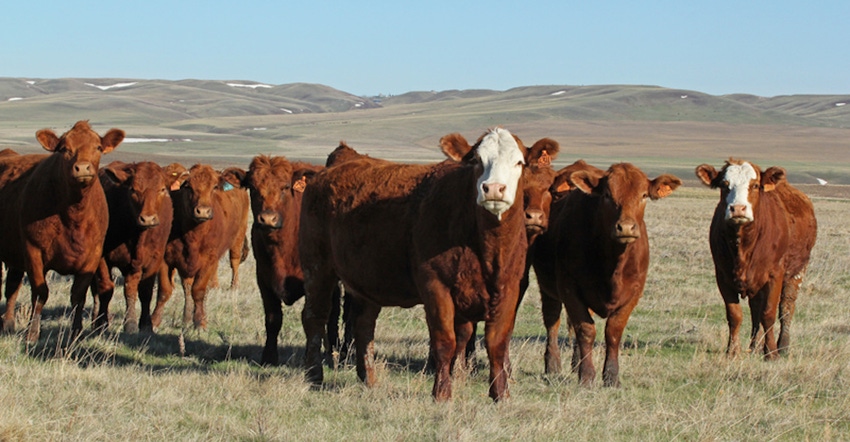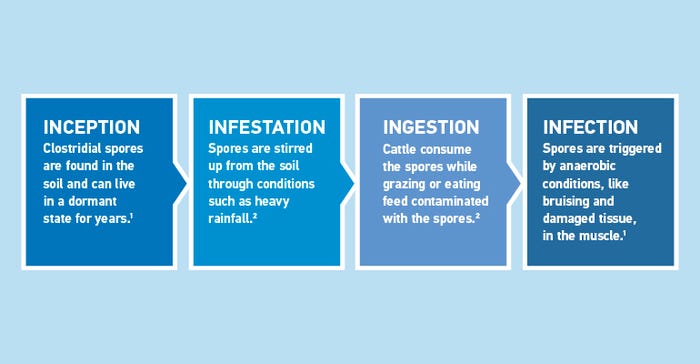Welcome to Health Ranch, where you can find information and resources to help you put the health and well-being of your cattle at the top of the priority list.
Learn more about blackleg, how it spreads and what you can do to prevent an outbreak.

Sponsored Content
Blackleg is a clostridial disease that can be devastating for beef producers.1 “It’s a disease that’s difficult to treat and often fatal,” remarked Dr. DL Step, professional services veterinarian with Boehringer Ingelheim. “When cattle are put out to pasture, it’s a great time for producers to start taking steps toward clostridial disease prevention.”
Here, Dr. Step answers some of the most commonly asked questions about blackleg:
How does blackleg occur?
“Blackleg-causing clostridial spores can live in the soil wherever livestock have been kept,” said Dr. Step. Figure 1. outlines the path of clostridial spores from the soil to infection of the animal.

The path of clostridial spores from the soil to infection of the animal.
What are the clinical signs?
In many cases, death is unfortunately the first and only clinical sign of blackleg and other clostridial diseases.3 Infected animals usually die within 12 to 48 hours.2 If clinical signs are seen, they’re typically lameness, swelling of a particular muscle and depression.1 Blackleg can be especially devastating because it commonly occurs in the best-performing animals between 4 months and 2 years of age.2
“Those animals are usually the most active, so they’re more prone to bruising,” Dr. Step said. “That creates an ideal environment for clostridial spores to replicate. They also tend to be animals who eat more aggressively, so their chances of ingesting clostridial spores increase.”
Is blackleg contagious?
Blackleg is not contagious. However, infected cattle can spread blackleg-causing spores in pastures and feed yards, increasing the risk of a future outbreak. So, disposing of the carcass appropriately is critical.2 “Eliminating blackleg spores from a cattle herd’s surroundings is incredibly difficult or impossible,” asserted Dr. Step. “That’s where vaccination comes in.”
When should I vaccinate?
“With proper management and vaccination, producers can prevent the loss of animals to blackleg and other fatal clostridial diseases,” Dr. Step noted. “Getting the vaccination program started with a single dose, seven-way clostridium vaccine at 3 to 4 months of age is a great way to protect the calf and the rest of the herd. An additional booster vaccination three to six weeks later is recommended for best protection.”
Dr. Step also encourages following Beef Quality Assurance guidelines on proper handling and administration of vaccines as well as working with a veterinarian to develop a vaccination program best suited for that operation’s needs.
References:
1. Cothren J. Blackleg in cattle still problem after thousands of years. North Carolina State University Cooperative Extension. 2014. Available at: https://wilkes.ces.ncsu.edu/2014/10/blackleg-in-cattle-still-problem-after-thousands-of-years/. Accessed Feb. 20, 2018.
2. Rodning SP, Owsley WF, Edmondson MA, et al. Blackleg and other clostridial diseases in cattle. Alabama Cooperative Extension, Alabama A&M and Auburn Universities. 2011. Available at: http://www.aces.edu/agriculture/livestock-poultry/beef/documents/ANR-0888-BlacklegandotherClostridialDiseases.pdf. Accessed Feb. 20, 2018.
3. McGuirk SM. Managing clostridial diseases in cattle. School of Veterinary Medicine, University of Wisconsin. Available at: https://www.vetmed.wisc.edu/dms/fapm/fapmtools/7health/manage-clostridial.pdf. Accessed Feb. 20, 2018.
© 2018 Boehringer Ingelheim Vetmedica, Inc. BOV-1240-CLOS0418
About the Author(s)
You May Also Like
